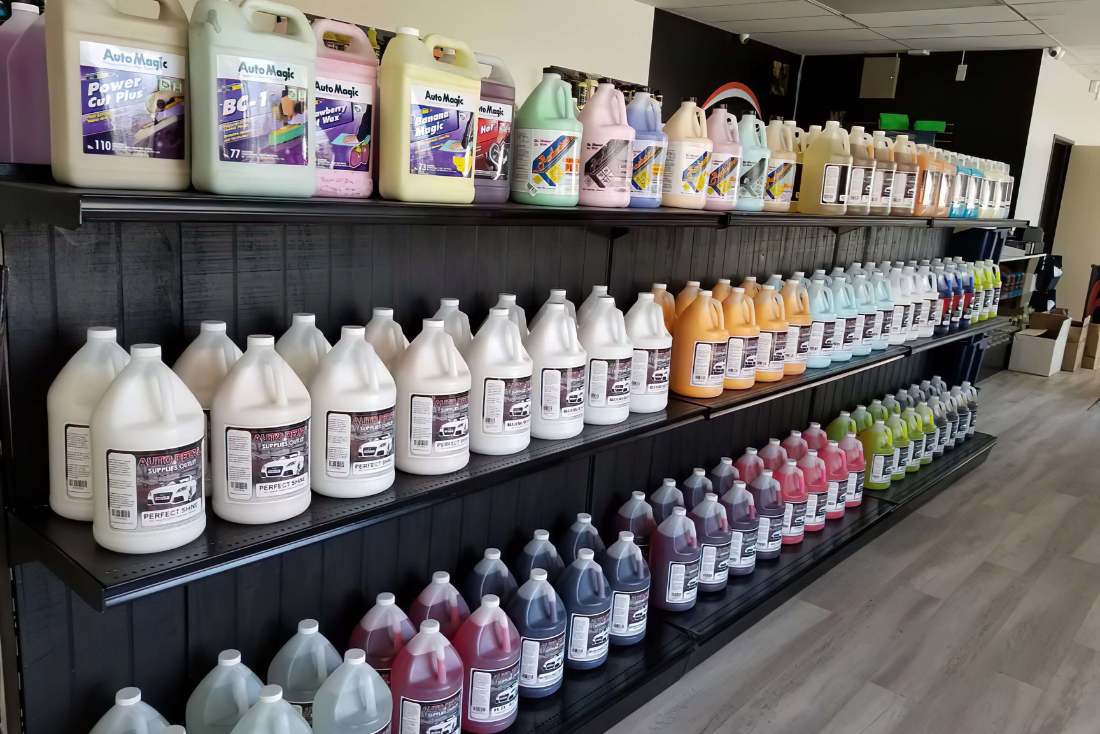
Equip yourself with professional-grade tools to achieve professional results. This guide organizes our tools by job, from machine polishers for paint correction to DI tanks for a spot-free rinse. Visit our Baldwin Park store to find every tool you need.

Use a machine polisher to apply compounds and polishes safely and effectively. Select a dual-action (DA) polisher for a safe, swirl-free finish, or choose a rotary polisher for heavy, fast correction.
Use a DA polisher's oscillating (wobble) motion to prevent paint burning. This machine removes swirls safely and corrects paint efficiently, making it the ideal choice for beginners and enthusiasts.
Use a rotary polisher’s direct, spinning motion to remove deep scratches and heavy oxidation fast. This tool requires advanced skill to control heat and avoid buffer trails (holograms).
Match your backing plate size to your polishing pad. Select a smaller (e.g., 3-inch) backing plate to polish intricate areas like pillars and bumpers. Choose a larger (e.g., 5-inch or 6-inch) plate to correct large panels like doors and hoods efficiently.

Select the correct microfiber towel for each task. Use high-pile (plush) towels for drying and waterless washes. Use low-pile (utility) towels for interior cleaning and ceramic coating removal.
Use a high-pile, high-GSM (grams per square meter) towel to absorb large volumes of water safely. The plush fibers pull water away from the paint to prevent scratches and streaks.
Use a low-pile (shorter fiber) towel for cleaning interiors or wiping off polish. The tighter weave provides more “bite” to scrub grime and prevents fibers from snagging or linting.
Apply ceramic coatings with a suede applicator block. Use a short-loop, edgeless microfiber towel to level (wipe off) the high spots of the coating before it cures.

Use specialized brushes to clean hard-to-reach areas safely. Select a boars-hair brush for emblems and trim, a wheel brush for barrels, and a fabric brush for interior agitation.
Use a soft, boars-hair or synthetic-bristle brush to agitate cleaners around emblems, window seals, and interior vents. The soft bristles prevent scratching on delicate piano black trim.
Select a wheel brush with a long, flexible handle to clean the inner barrels of your wheels. Use a separate, stiff-bristle tire brush to scrub old dressings and dirt from the tire's sidewall.
Pair a medium-stiff nylon brush with your fabric or leather cleaner. Gently agitate the surface to lift embedded dirt and stains from the grain or fibers.

Create thick, lubricating foam to pre-wash your vehicle. Connect a foam cannon to a pressure washer to apply soap before you touch the paint, reducing the risk of wash-induced swirls.
Use a foam cannon to apply a thick layer of high-pH soap like 360 Foam Master. Allow the foam to dwell (sit) on the vehicle to break down road film and grime before you make contact with a wash mitt.
Choose an electric pressure washer (1100-1900 PSI) for safe and effective car washing. Avoid high-PSI gas-powered washers, which can damage paint and fragile trim.
Fill one bucket with your soap like 360 optima wash or ADSO Wash n Wax solution and a second with plain water (the “Rinse” bucket). Place a Grit Guard at the bottom of each to trap dirt and prevent it from returning to your wash mitt.

Filter your wash water to remove all minerals and total dissolved solids (TDS). Rinse your car with deionized (DI) water to prevent water spots, allowing the car to air dry perfectly in the Baldwin Park sun.
Deionized water is water that has been stripped of all mineral ions (like calcium, magnesium, and sodium). These minerals are the "Total Dissolved Solids" (TDS) that cause water spots when they dry.
Pass your tap water through a DI tank. The ion-exchange resin pulls the minerals out, producing 0 TDS water. This ultra-pure water dries cleanly, eliminating the need to towel-dry your car.
Use a digital TDS meter to check your water purity. When the meter reads above 10 TDS, replace the deionizing resin in your tank to ensure a spot-free rinse.